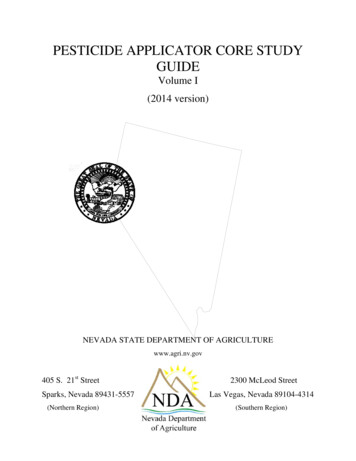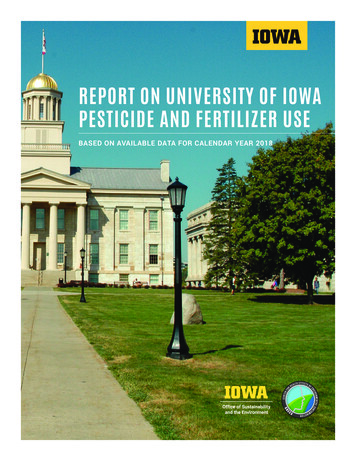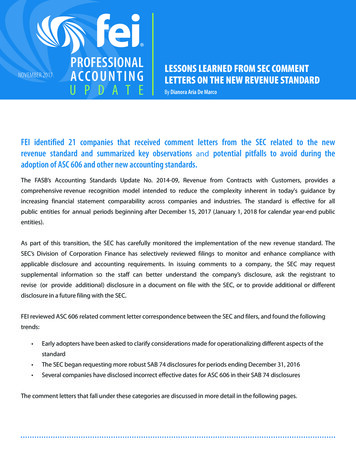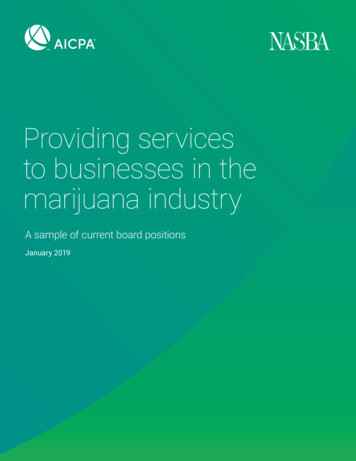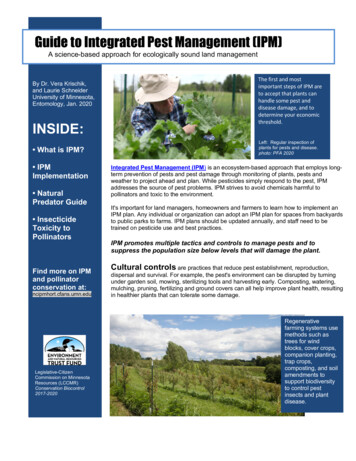
Transcription
A Guide forPesticide RegistrantsCalifornia Department of Pesticide Regulation
InsideTable of ContentsChapter 1: Introduction toPesticide Registration . 3IntroductionOverviewAuthority to RegulateDoes My Product/Device Require CaliforniaRegistration?What is a Pesticide?Types of ProductsTypes of RegistrationsChapter 2: How to Obtain aNew Product Registration . 11Quick GuideDetailed InformationCover LetterCalifornia Application for Pesticide RegistrationSix Copies of the Proposed Marketing/Production/Container Label, or if OnlyRegistering a Master Label, the Master LabelData to Support RegistrationU.S. EPA DocumentationApplication FeesDesignated Agents/Representative LetterChapter 3: Pesticide Product Registrations General Review Procedures . 21Processing the ApplicationEvaluation ProcessRequirement to Post for Public CommentLicensingOmbudsman – Point of ContactChapter 4: How to Maintain aProduct Registration . 27Label AmendmentsFormula RevisionsCompany Name and/or Ownership Changesand Product TransfersRenewalsProduct Inactivation/DiscontinuanceMill AssessmentRisk AssessmentReevaluationAdverse Effects Reporting Requirements2 Pesticide Registration Manual: Chapter 1Chapter 5: Pesticide-RelatedAreas of Interest . 41Broker LicensesProp 65 List“Doing Business as,” “A Division of,” or“A Subsidiary of”Two Products with the Same Brand NameATCC Numbers for Antimicrobial ProductSection 18 Emergency ExemptionsSection 24(c) Special Local NeedsPesticide Products Prohibited from Schoolsand Child Care FacilitiesResearch AuthorizationsAppendicesAppendix A: Glossary of Terms . 48Appendix B: Guide for DeterminingSubstantially Similar . 59Appendix C: Fact Sheet: Section 18:Emergency Exemptions . 60Appendix D: Fact Sheet: Section 24(c):Special Local Need Registrations . 65Appendix E: Fact Sheet: ResearchAuthorizations . 69Appendix F: Fact Sheet: ExperimentalUse Permits . 73Appendix G: Fact Sheet: CaliforniaMaster Labels . 78Appendix H: Fact Sheet: Section 25(b) PesticideProducts Exempt from Registration . 81Appendix I: Fact Sheet: Amendment,Notification and Non-NotificationTables . 84Index . 95Acknowledgements . 98On the cover: Diabrotica. In the twentieth century, Diabrotica became a major pestof maize in North America as maize growing areas increased. The practice ofcontinuous maize growing was largely responsible for the expanding range of D.virgifera virgifera. Photo: Alex Wild, www.alexanderwild.com.
Chapter 1Introduction to Pesticide RegistrationTable of ContentsIntroductionOverviewAuthority to RegulateDoes My Product/Device Require California Registration?What is a Pesticide?Tips oTypes of ProductsPeriodimarks,mice arTypes of Registrations The beschool Monitocan beor tracsuspec If possmice m Set traplaces Use m Thinkrodent Exclusmouseand el1/4 inother Germamonito Pigeonroostinclusiowill reCalifornia Department of Pesticide Regulation 3
IntroductionOverviewThe purpose of this manual is to provide guidance to the Department ofPesticide Regulation’s (DPR) stakeholders on applying for pesticide productregistration and amendments. Topics include: Guidance on determining if a product requires registration. Types of product registrations. Submitting an application for registration of a new product or amendmentof a currently registered product. The internal registration process at DPR. Maintaining a product registration. Other related topics such as mill assessment, enforcement, and productinactivation/discontinuance.Authority to RegulateThere are both federal (U.S.) and state laws that govern the manufacture, sale,distribution, and use of pesticide products.The federal authority to regulate pesticides is found in the Federal Insecticide,Fungicide, and Rodenticide Act (FIFRA) and the Code of Federal RegulationsTitle 40 (40CFR), Parts 150 to 189. The U.S. Environmental Protection Agency(EPA) is responsible for regulating pesticides at the federal level.A State’s authority to regulate pesticides is found in FIFRA, section 24(a)and reads, “A State may regulate the sale or use of any Federally-registeredpesticide or device in the state, but only if and to the extent the regulation doesnot permit any sale or use prohibited by this Act.” DPR is given further authorityin the following sections of California law and regulations:California Food and Agricultural Code (law), Division 6, sections 11401 - 12408California Food and Agricultural Code (law), Division 7, sections 12500-14155and 15300-15340California Food and Agricultural Code (law), Division 13, sections 2900029103Business and Professional Code (law - structural) Division 3, Chapters 14-14.5California Code of Regulations, Title 3, Division 6, sections 6000-6960California Code of Regulations, Title 16, Division 19, sections 1900-1999.54 Pesticide Registration Manual: Chapter 1Note: In the field ofpesticides, FIFRA clearlystates that only thefederal government hasauthority over pesticidelabeling. In otherwords, no state or localgovernment can dictatewhat is on a pesticideproduct label. However,a state can refuse toallow registration of aproduct and thereforethe possession, sale anduse of any pesticide notmeeting its own healthor safety standards.States can also adoptregulations moreprotective of health andthe environment than ona product label.
Does My Product/Device RequireCalifornia Registration?What is a Pesticide?California Food and Agricultural Code (FAC) section 12753 defines a pesticideas any of the following:(1) Any substance or mixture of substances which is intended to beused for defoliating plants, regulating plant growth, or for preventing,destroying, repelling, or mitigating any pest, as defined in FACSection 12754.5, which may infest or be detrimental to vegetation,man, animals, or households, or be present in any agricultural ornonagricultural environment whatsoever.(2) Any spray adjuvant.Further, a “pest” is defined in FAC section 12754.5 as any of the followingthat is, or is liable to become, dangerous or detrimental to the agricultural ornonagricultural environment of the state: Any insect, predatory animal, rodent, nematode, or weed. Any form of terrestrial, aquatic, or aerial plant or animal, virus, fungus,bacteria, or other microorganism (except viruses, fungi, bacteria, or othermicroorganisms on or in living man or other living animals). Anything that the director, by regulation, declares to be a pest.A product requires registration in California if:(1) The U.S. Environmental Protection Agency (U.S. EPA) Office ofPesticide Programs requires registration of the product (excluding PlantIncorporated Protectants) and the product is sold, distributed, or usedin California.(2) California law requires registration of the product even if U.S. EPA doesnot (e.g., spray adjuvants, structural pest control devices, certain FIFRA25(b) products).California Department of Pesticide Regulation 5
Types of ProductsCertain products require both federal and state registration while othersrequire only state registration. The following information will help determinewhich products require registration in California:Products that require U.S. EPA and DPR registration Technical grade active ingredient (TGAI) and manufacturing useproducts (MUPs): Defined as any federally registered product that isdistributed or sold for manufacturing, formulation, reformulation, orrepackaging into other pesticide products must be registered.California requires the registration of TGAI products and MUPs that are:Manufactured in California (excludes products manufactured solelyfor export out of California), orUsed in California to manufacture or formulate an end-use product(excludes products manufactured or formulated for export out ofCalifornia).If the raw material is registered at U.S. EPA as a pesticide, then it mustbe registered in California before being delivered or sold into Californiafor use in the formulation of any pesticide (MUP or End Use) within thestate.Spray adjuvants labeled solely for manufacturing use or repackaginginto end-use spray adjuvants are not required to be registered, butspray adjuvants products with labels that include both manufacturing/repackaging and end-use directions require registration with DPR.6 Pesticide Registration Manual: Chapter 140 CFR 152.3
End-use products: products sold, used, or distributed in California (e.g.,disinfectants, sanitizers, agricultural chemicals, certain pheromones,home and garden products, etc.) for pesticidal purposes that are notTGAIs or MUPs.40 CFR 152.3Note: End-use products manufactured in California for sole shipmentoutside the state do not require DPR registration. California Master Labels: A California Master Label is defined by DPRas a pesticide product label bearing most or all U.S. EPA accepteduses for that product, but that the company does not intend to marketfor sale or use in California. Master label products cannot be soldor distributed in California. To sell, use or distribute the product inCalifornia, the registrant must also register the end-use product, even ifthe labels are virtually identical. For more information, see ster labels.pdf or Appendix G.40 CFR 152.3Additional products that require California registration Additional/alternate brand names: pesticide products sold underalternate brand names in California require separate registrations.FAC 128213 CCR 6152Note: Applicants must notify U.S. EPA of all alternate brand namesthrough their notification process (see U.S. EPA form 8570-1). Supplemental distributor products: products distributed or sold underanother company’s name and address (also known as supplementalregistrations or subregistrants; must have the same formulation, label,and packaging as the basic manufacturer).40 CFR 152.132Note: Supplemental distributors must submit to U.S. EPA a statement(U.S. EPA form 8570-5) signed by both the registrant and the distributoracknowledging their agreement.California Department of Pesticide Regulation 7
Spray adjuvants (often referred to as “adjuvants”): products that areintended to be used with other pesticides to aid the application orenhance the effect of that pesticide (e.g., wetting agents, pH modifiers,stickers, spreaders, etc.). As previously noted, spray adjuvants labeledsolely for manufacturing use or repackaging into end-use sprayadjuvants do not require registration. However, spray adjuvant productswith labels that include both manufacturing/repackaging and end-usedirections require registration with DPR.FAC 12758 Structural pest control devices: any device or method used to mitigateany wood destroying pest.CA Notice 2000-7FAC 15300 Certain FIFRA 25(b) products: FIFRA section 25(b) products mustbe registered unless they meet the exemption requirements outlinedin California Code of Regulations section 6147 (e.g., 1% citronellaproducts for topical use, products not labeled according to Californiaregulation, etc.). For more information, see ction25b.pdf or Appendix H.FIFRA 25(b)(136w.(a)2[b])3 CCR 6147Products that do not require DPR or U.S. EPA registration Fertilizers and soil amendments: Products intended solely for use asfertilizers are regulated by the California Dept. of Food and Agriculture(CDFA). Devices (not including structural pest control devices for wooddestroying pests in California): physical or mechanical means to trap,destroy, or mitigate a pest which do not include a pesticidal substance(e.g., fly traps, glue boards, mouse traps, sound generators, ozonegenerators, water treatment devices,* etc.).*In addition, water treatment devices are regulated by the CaliforniaDepartment of Health.Note: Other requirements do apply to pest control devices. U.S.EPA requires companies that manufacturer pest control devices toobtain U.S. EPA establishment numbers for their products –for moreinformation go to tm.8 Pesticide Registration Manual: Chapter 1Note: Products labeled orintended for use as bothfertilizers and pesticidesmust be registered byboth DPR and CDFA.FIFRA 2(h)(136 ([h])
Human/Animal Drugs: products intended to control viruses, bacteria,microorganisms or pests regulated by another agency, on or in livingman or other animals (e.g., lice control, internal parasite control,athlete’s foot products, etc.). Note: These products are regulated by anumber of different agencies (FDA, CDFA, etc.).40 CFR 152.6 Products that are not considered pesticides and are specificallyexempted in 40 CFR Parts 152.8, 152.10, and 152.20, that also meet thecriteria for exemption under 3 CCR section 6147. Treated articles: articles treated with a registered pesticide to protectthe article itself (e.g., paints treated with a pesticide to protect thepaint coating, plastics or other materials treated to prevent mold fromaffecting the material itself). For additional information, see U.S. EPAPesticide Registration Notice 2000-1.40 CFR 152.25Note: Pesticidetreated clothing (e.g.,permethrin treatedclothing) or otherpesticide treatedmaterials that claimto protect the userare not consideredtreated articles andmust be registered aspesticides by both U.S.EPA and DPR.California Department of Pesticide Regulation 9
Types of RegistrationsProduct registrations and exemptions from registration in California fall intothe following types: Full registration – is one that has fulfilled all California registrationrequirements (known federally as a FIFRA section 3 registration).Note: Most products are registered under this section. Conditional registration is a registration conditioned upon the completionof certain specified data requirements. Examples might be a 1-year storagestability study or additional efficacy data. Once conditions of registrationhave been met, the conditions are removed and a full registration can begranted. Experimental Use Permit (known federally as a FIFRA section 5registration).An Experimental Use Permit is a permit issued by U.S. EPA that allowsa person/company to test an unregistered pesticide product or anunregistered use of a currently registered product, to develop the datanecessary to register the product under Section 3 of FIFRA. FIFRA section 18 - Emergency Exemption from registration.FIFRA section 18 authorizes use of an unregistered pesticide in a state fora limited time if U.S. EPA determines that emergency conditions exist. FIFRA section 24(c) - Special Local Need (SLN) registration.FIFRA section 24(c) allows states to register new products or an additionaluse of an existing product to address a pest situation that is existing orimminent, and that a Section 3 product cannot currently mitigate. FIFRA section 25(b) – Exemption from registration.Exempts certain pesticide products from registration.10 Pesticide Registration Manual: Chapter 1Note: the fact that aproduct is conditionallyregistered federally doesnot automatically mean itwill be given a conditionalregistration in CA.
Chapter 2How to Obtain a New Product RegistrationTable of ContentsQuick GuideDetailed InformationCover LetterCalifornia Application for Pesticide RegistrationSix Copies of the Proposed Marketing/Production/Container Label, or if OnlyRegistering a Master Label, the Master LabelData to Support RegistrationU.S. EPA DocumentationApplication FeesDesignated Agents/Representative LetterCalifornia Department of Pesticide Regulation 11
How to Obtain a New ProductRegistrationThe following submission requirements apply to: New products not currently registered with DPR that contain new activeingredients. New products not currently registered with DPR that contain activeingredients found in other products currently registered with DPR. Products currently registered with DPR but are intended to be sold underadditional/alternate brand names in California. Supplemental distributor (sub-registrant) products not currentlyregistered with DPR. California Master Label products.12 Pesticide Registration Manual: Chapter 2
Quick GuideTo apply for a new product registration, the following are required: Cover letter (strongly recommended). California Application for Pesticide Registration. Six copies of the proposed marketing/production/container label,or if only registering a master label, the master label, printer’s proof,or copies thereof. Data to support registration. U.S. EPA documentation. 1,150 application fee. Designated agent letter (when applicable).Mail applications to the assigned Regulatory Scientist (if none has beenassigned, address your application to Pesticide Registration Branch) at:(Packages sent via UPS, DHL, Fed-Ex, etc.)California Department of Pesticide RegulationPesticide Registration Branch1001 I StreetSacramento, California 95814-2828(Packages sent via U.S. Postal Service)California Department of Pesticide RegulationPesticide Registration BranchP.O. Box 4015Sacramento, California 95812-4015California Department of Pesticide Regulation 13
Detailed InformationCover letterEach submission should be accompanied by a detailed cover letter. DPRsuggests the following information be included: The registrant’s (company) name, address, and contact information (e.g.,telephone number, e-mail address). Note if the package has been submitted by a designated agent on behalf ofthe registrant. The product name. The EPA registration number (if applicable) or a statement that the productdoes not require federal registration. The reason for submission of the package (e.g., request for new end-useproduct registration, master label, supplemental distribution, etc.). Requests for data waivers or references to data waivers included with thepackage (if applicable). For supplemental distributors – note if the basic registrant’s product iscurrently registered with DPR. Whether data are being submitted to support the product registration,data were previously submitted by the registrant or another registrant/trade group, or if the registration will rely on data submitted by anotherregistrant/trade group. If referencing data on file with DPR include the DPR Study ID#, Document ID#,Tracking ID#, or other DPR identification numbers (if known to the applicant). If the applicant plans to rely upon data on file with DPR to support asubstantially similar product(s), include the product name(s) and U.S. EPAor DPR registration number(s). See Appendix B for guidance on determining“substantially similar.” Whether or not additional items (e.g., CSF or supporting data) will or havebeen sent separately by a third party. Note if requesting to submit the product concurrently with submission ofan application to U.S. EPA for federal registration, include a justification forthe concurrent submission (most products require federal registration priorto submission at DPR). See California Notice 2015-03 15/ca2015-03.pdf). If only a draft label is submitted, note that container labels (or copies) willbe submitted to DPR prior to final acceptance.14 Pesticide Registration Manual: Chapter 2
California Application for Pesticide RegistrationTo apply for registration of a pesticide product in California, a CaliforniaApplication for Pesticide Registration (DPR-REG-030) must be filled out andsubmitted to DPR.General information on submitting an application: The application must be signed and dated by the registrant or adesignated agent. The registrant’s company name and address must be consistent with thecompany’s information on file with U.S. EPA. In lieu of the California Product Formulation Information sheet (page 3 ofthe California application), the applicant may substitute a copy of the U.S.EPA Confidential Statement of Formula (CSF). All alternate formulas/CSFs must be submitted to DPR even if the onlydifference in the formula is a fragrance, varied paint color, or the addition offertilizer components. If the applicant is a supplemental distributor and does not have access tothe basic registrant’s CSF, they may note the following in their cover letterand on the formulation sheet:The basic registrant’s product formulation is currently on file with DPRand should be referenced, orA copy of the basic registrant’s product formulation has been requestedby the applicant and will be provided directly by the basic registrant.California Department of Pesticide Regulation 15
Six Copies of the Proposed Marketing/ProductionContainer LabelGeneral Guidance on Submitting Marketing/Production/Container, or ifOnly Registering a Master Label, the Master Label: Submitted label must be identical to that on record at U.S. EPA and mustinclude all revisions identified in the U.S. EPA letter of acceptance or formalcorrespondence, with the following exceptions:The address on the label may differ.Use sites may be deleted.Bilingual text added to the federal label by non-notification may appear onthe label (but is subject to DPR review). If a label is resized before it is submitted, it must be legible and the applicantmust indicate the percentage reduction or enlargement. U.S. EPA provides guidelines for label formatting (applicable to productsthat require federal registration), however, exceptions are made at theirdiscretion. See the U.S. EPA Label Review Manual for details.Note: DPR requires six copies of the proposed marketing/production/container label, or if only registering a master label, the master label besubmitted for review and acceptance. The six copies may be printer’s prooflabels, final printed labels, or copies thereof. As noted, if the submitted labelsare not final printed or printer’s proof, the applicant should acknowledge in acover letter that printer’s proof or final printed labels will be submitted to DPRprior to the license being issued.A license will not be issued until final printed labels, printer’s proof labels,or copies thereof have been submitted.Multiple Container SizesMany pesticide products are sold in more than one container size. If the labellanguage varies on the different size containers (e.g., precautionary or storageand disposal statements), six labels for each representative size that hasdifferent language must be submitted if different sizes will be sold, used ordistributed in California. For example, a product may be sold in 2, 5, 10, and50-pound bags. The label language may be identical for the 2 and 5-poundbag, but the 10 and 50-pound bags require different disposal or precautionarystatements. In this case, the applicant should submit six copies of either the 2or 5-pound bag and six copies of either the 10 or 50-pound bag.16 Pesticide Registration Manual: Chapter 2
Colors, Dyes, Fragrances, and FertilizersMany pesticide products are sold with varying colors, dyes, fragrances, or ascombination pesticide/fertilizer products. A registrant must submit six copiesof printer’s proof, final printed labels, or copies thereof for each representativecolor, dye, fragrance, or fertilizer variation they intend to sell, use or distribute inCalifornia. They must also submit a separate confidential statement of formulaor product formulation sheet for each color, dye, fragrance or fertilizer variation,since each will have minor differences in the inert ingredients. It should benoted that pesticide/fertilizer products are regulated by both DPR and theCalifornia Department of Food and Agriculture.In all cases, the labels require review and acceptance by DPR but no fee is requiredfor the additional labels as long as the size, color, dye, fragrance, or fertilizercomponent are not considered part of the brand name (some exceptions apply toantimicrobial products). They are not considered separate registrations.Note: If the size, color,dye, fragrance, orfertilizer componentis included as part ofthe brand name, thesubmission is consideredan additional/alternatebrand name and mustbe registered as aseparate product perFAC section 12821. Aseparate applicationand registration fee arerequired.California Department of Pesticide Regulation 17
Data to support registrationAll products proposed for registration in California must be supportedby scientific data. Information on California’s data requirements canbe found online at apter 03.pdf.FAC 12824All data required by 40 CFR, Part 158 or 161 for federal registration,regardless of submission to U.S. EPA, must be submitted to DPR. Inaddition, any study not identified in federal regulations, but required byU.S. EPA to support registration of the pesticide product, is also requiredby DPR. For example, federal regulations require that all registrantsgenerate product performance data, but U.S. EPA does not generallyrequire this data be submitted to support registration of non-publichealth products. DPR requires submission of product performance datafor all products.3 CCR 6170In addition, DPR may require supplemental data to support theregistration or amendment of a pesticide product (e.g., hazards to bees,indoor exposure).3 CCR 6176-6199.7In lieu of relying on data submitted with an application, DPR may relyupon the evaluations of previously submitted data, regardless of dataownership, to support the registration or amendment of a pesticideproduct. If an applicant does not supply a complete data set, andintends for DPR to rely on another company’s data to support itsregistration application, the applicant may be required to offer topay the data owner a share of the cost of producing the data. Forinformation, see ce.htm. This does not apply to applicants that rely upon their own data thatis currently on file with DPR.FAC 12811.5Applicants are reminded to specify in their cover letter if they intend for DPR torely upon the evaluations of previously submitted data. DPR does not requirecertain residue data. See CA Notice 2004-7 for federally-required studies thatare not required by DPR .Formatting dataDPR requires that data submitted for review be organized and bound in aspecific manner. Improperly bound data will be returned or shredded, andwill not be reviewed. See California Notice 2006-06 for format guidelines.18 Pesticide Registration Manual: Chapter 23 CCR 6159CA 2004-7Note: DPR requires thatdata submitted for reviewbe organized and boundin a specific manner.Improperly bound datawill be returned orshredded, and will not bereviewed. See CaliforniaNotice 2006-06 forformat guidelines.
U.S. EPA documentationThis does not apply to adjuvants or other products that do not require federalregistration! See Chapter 1 for information on products that do not requirefederal registration.U.S. EPA stamped-accepted label and accompanying letter of acceptanceApplicants must submit a copy of the most current U.S. EPA stamped-acceptedlabel and accompanying letter of acceptance.Note: If a product is being reviewed concurrently by U.S. EPA, proof of federalregistration must be provided before the product will be registered in California.If a U.S. EPA stamped-accepted label and accompanying letter is not providedwith the application, an explanation must be provided in the cover letter. Todetermine if the product qualifies for concurrent review, see FAC sections12836 and12836.5, and California Notices 2015-03.Additional correspondence to/from U.S. EPAOnce a product label is stamped-accepted by the U.S. EPA, any documentsrelevant to that label (i.e. federal amendments, notifications, etc.) shouldbe submitted to DPR. In addition, any written (e-mail or hard copy)correspondence between the registrant and U.S. EPA pertinent to thecurrent stamped-accepted label or cover letter should also be submitted.Examples include: Amendments submitted through the federal notification process thatare not included on the most current stamped-accepted U.S. EPA label(applicant should submit a copy of completed notification form). Removal of restrictions or requirements outlined in the cover letteraccompanying the stamped-accepted label.Additional/alternate brand name formRegistrants are required to notify U.S. EPA using form 8570-1, when distributinga product under an additional/alternate brand name. A copy of this completedform must be submitted to DPR. However, U.S. EPA’s return response to thecompany is not required.Supplemental distributor formIf the applicant is a supplemental distributor, U.S. EPA’s Notice of SupplementalDistribution of a Registered Pesticide Product form (8570-5) must be signedand dated by both the basic registrant and the supplemental distributor andsubmitted to DPR. This form is required whether or not the basic registrant isregistered in California.California Department of Pesticide Regulation 19
Application feesAll new products 1,150 (new and currently approved activeingredients)Interim registrations 5,000 (in addition to the 1,150 application fee)Structural devices 200All application fees are processing fees, are non-refundable, and do notguarantee registration of the product.Make check or money order payable to “Cashier, State of California.”Payment cannot be made by credit card at this time.Designated agents/representative letterA “designated agent” is a designated member of a firm, an independentconsultant, or similar representative
4 Pesticide Registration Manual: Chapter 1 Introduction Overview The purpose of this manual is to provide guidance to the Department of Pesticide Regulati



